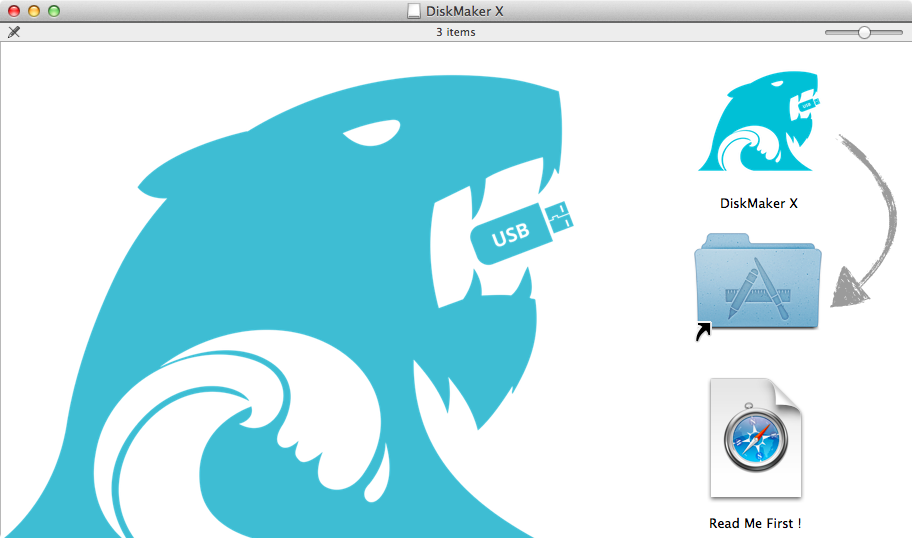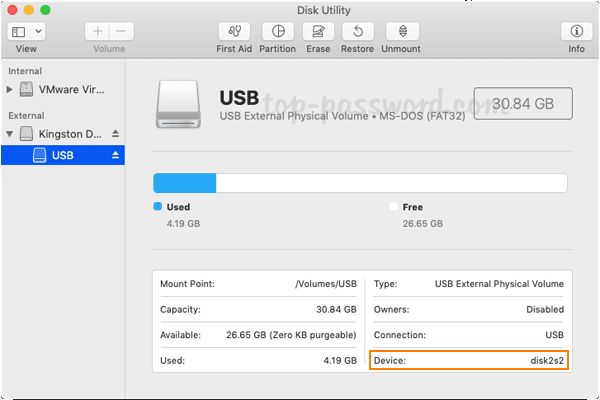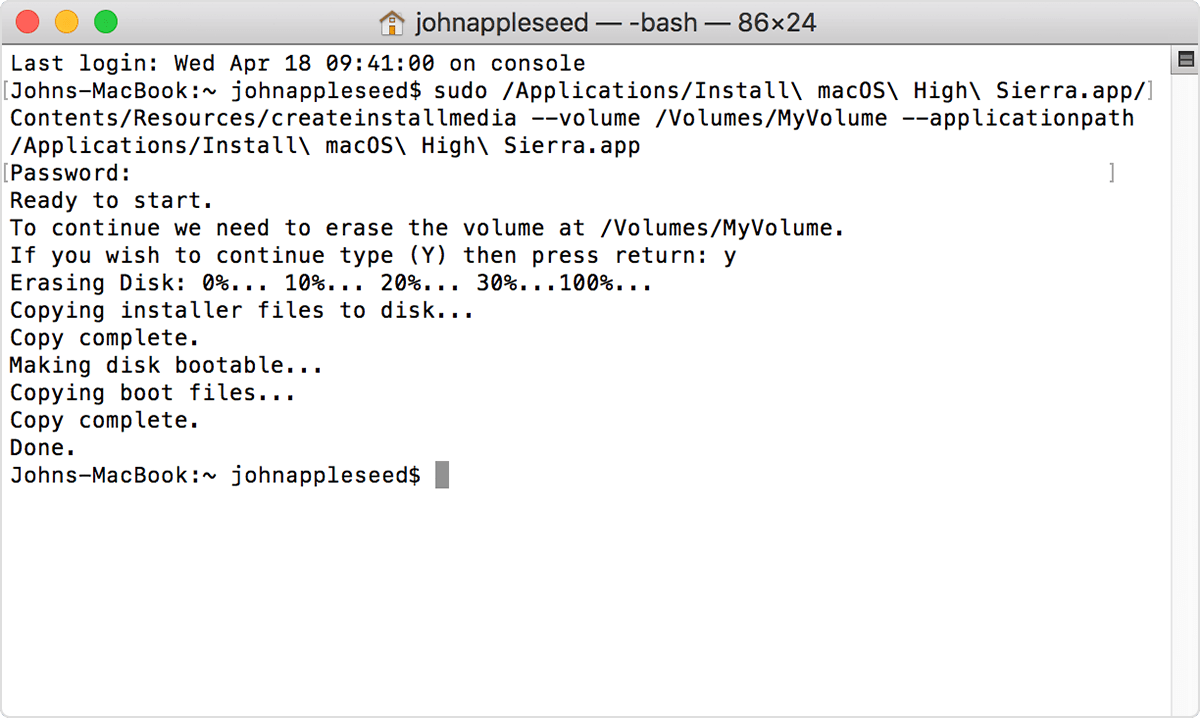Boot Usb For Mac
The OS on my Mac recently stopped working and in order to fix the issue I needed to use a bootable USB drive to reinstall the OS. I'm going to take you throu. Sep 14, 2015 How to start up your Mac from an external USB storage device If your USB thumb drive, USB external disk or flash storage contains a usable operating system or a macOS installer, you can select it at boot time using macOS’ built-in feature called Startup Manager, which can be invoked via a simple keystroke. 1) Turn on or restart your Mac.
If you own a Mac and would like to run Windows on your device, you will need to create a Windows 10 bootable USB. You can use your Mac, even if it is running Mac OS to create this. It can also be useful if you want to install Windows on a new PC that you have built or if you have replaced the hard drive on your PC and you need to reinstall Windows 10. There is a range of other reasons as to why you may need to create a Windows 10 bootable USB. This article will show you how to create a Windows 10 bootable USB in 4 different ways.
Method 1: Use Boot Camp Assistant on Mac
In order to create a bootable USB using Boot Camp, you will require a USB that has 16GB of storage, or more. Please note that Boot Camp is not supported in macOS Mojave and later.
Insert a USB drive into your Mac.
Open Bootcamp Assistant on your Mac.
Tick the box for 'create a Windows 7 or later version install disk' and uncheck the 'Install Windows 7 or later version' option. Then click on continue.
Download a Windows 10 .iso file from the Microsoft website or another reliable site. Keep this in a location that is easily found (such as the Downloads folder).
Bootcamp will locate the downloaded iso file automatically however if it is not found, you can use the'choose' button to locate it manually.
Click on Continue and wait until the USB is formatted and set up to become a bootable drive.
Once the process has been completed by the Bootcamp Assistant, the USB will have been renamed. You can now quit Bootcamp and then Eject the USB to safely remove it.
This will have created a Windows 10 bootable USB using a Mac that can now be used on your PC.

Method 2: Use Disk Utility on Mac
If you are running an older version of Mac, you can use the built-in Disk Utility app to create a Windows 10 bootable USB drive. As this is only compatible with older versions of Mac OS, it is recommended that you use an alternative method.
Bootable Usb For Mac Os On Windows
Plug in your USB and open the disk utility tool.
Right-click on your USB drive on the left and format the drive (which will remove all the data) with MS-DOS (FAT).
Drag the Windows ISO file to the USB drive and the ISO file will begin to write on the USB.
How To Make Boot Usb For Mac
Method 3: Use UNetbootin on Mac
UNetbootin is free to use and allows you to make a bootable USB drive for Windows 10 using your Mac. Again, like the first method, you will need a USB drive (with a capacity of 16GB as a minimum recommendation) and you will also need to download the .iso file and keep it in a memorable location.
Plug in your USB drive into your Mac.
Open Disk Utility and select your USB drive on the left. Click on the info button and write down the device name.
Download and install the UNetbootin utility.
Choose the 'Diskimage' button and then click on the '…' button to select the iso file that you have downloaded.
Set the Type as USB Drive and select the device name of your USB drive that you have noted down earlier.
Click OK and wait for the USB to be formatted to a bootable drive.
Method 4: Use Terminal on Mac
The Terminal app is more complicated to use than other methods however it does not require you to use a third-party application in order to create a Windows 10 bootable USB drive. Again, you will need a USB drive.
Connect your USB drive to the Mac and then launch Terminal.
Type 'diskutil list' and hit the enter/return key to see a list of all connected drives.
Identify your USB drive and note down the name, such as disk3.
Run the command 'diskutil eraseDisk MS-DOS 'WINDOWS10' GPT disk3' without the quotation marks and you can replace the '3' at the end with the correct number.
Download the iso file for Windows 10 and save it in the Downloads folder if it hasn’t been saved there already.
Mount the .iso image by using the command 'hdiutil mount ~/Downloads/WINDOWS10IMAGE.iso' where you can replace the 'WINDOWS10IMAGE with the name of your downloaded file. Note the name of the mounted iso, which can be found by looking at the terminal. It will be similar to /Volumes/MOUNTED-NAME.
Next, run the command 'cp -rp /Volumes/MOUNTED-ISO/* /Volumes/WINDOWS10/' where you can replace MOUNTED with the name of your mounted ISO.
Once the command has finished and your files have been moved over to the USB drive, you will need to run the command 'hdiutil unmount /Volumes/MOUNTED-ISO', again replacing the word MOUNTED with the correct name.
Close the terminal and eject your USB drive. This can now be used as a bootable drive.
Additional Tip: One Click to Create Windows 10 Bootable USB to Reset Password
If you want to create Windows 10 bootable USB to reset the login password, we recommend a very easy to use tool to you. It is Passper WinSenior. This is only compatible with Windows however it is much easier than using the above methods which require you to complete most of the work. WinSenior automatically completes the process for you so there is a much lower risk of failing when trying to create a Windows 10 bootable USB drive. This is the recommended method when using third-party software. As this tool is extremely easy to use, it can be used by anyone. This is because you do not need any expert knowledge in how Windows works in order to reset a password.
Check more details here to know how to use Passper WinSenior.
Sep 28, 2020 • Filed to: Solve Mac Problems • Proven solutions
A Universal Serial Bus or USB Drive, also known as a flash drive is a portable data storage device that includes a memory which includes a USB interface. It is typically removable and much smaller than an optical disc. Any sort of data can be stored in this device. The drives are available in various sizes and as of to date, the 2TB(Tera-Byte) flash drives in terms of storage capacity are the largest ones available in the market.
Today, these drives are one of the most consumed used devices in the world. Thanks to their portable nature, affordability, and compatibility, USB drives are being used to send and receive endless information across a surplus of networks and platforms all around the globe. This small tool has opened the world to a stream of limitless options with respect to storing, transferring, copying data, and much more. One of them includes Booting the Mac from such a device.
Part 1. Reasons for Mac Boot from USB
Booting the Mac from USB in a way gives the power back to the user. The likeliest of the reason for choosing the boot from the USB method is that your Mac won't start which denies the user access to the computer. Using an external source like the USB drive helps the user get around the problem. It provides the user access to the contents of the internal drive, assuming the data is safe and not corrupted. It also helps to repair the Mac disk with Disk Utility and other tools. Here are the top reasons why the user should choose to Boot Mac from USB:
- Allows the user to install a different version of macOS.
- It allows the user to test a new version before you make the decision to upgrade.
- Allows risk-free testing of the Beta version.
- Faster and efficient.
- By installing older versions through USB, it permits certain Apps to run which are not compatible with the latest macOS.
Part 2. Preparations for Booting Mac from USB
To ensure a risk-free procedure certain measure should be taken:
- The user should buy a name-brand flash drive.
- The USB should contain 16-32GB of free space.
- The user should scan the flash drive with some reputable Anti-Virus software.
- The user should check to see what size of ports they have on the Mac. A 12' Mac only contains a single C-Type port.
- Make sure to purchase the C port flash drive to avoid any inconvenience.
- It is advised that the user should go with a USB 3.0 supported drive, with a size of 16GB to ensure a swift transfer of data.
- The USB drive should be formatted with a supported GUID partition.
- It should contain an OS X installer or a usable operating system to work with.
Part 3. How to Create Bootable USB on Mac
There are a few general guidelines that can help get your machine started which are mentioned above, regardless of the OS the user prefers. Here are the methods to create a bootable USB drive on Mac.
Creating a Bootable USB Using Terminal
The terminal is the default gateway to the command line on a Mac. It is just like the Command Prompt feature works for MS Windows. The Terminal feature ensures a hassle-free experience for the Mac user without the conventional pointing and clicking, the user just has to type the commands and the computer does the rest. The user can find Terminal in the Applications > Utility folder or it can be checked in the finder utility.
Using the Terminal feature is the most simple way to create the bootable USB drive. Adobe block hosts 2019. The user just needs to follow one easy step which is renaming the MyVolume portion of the command with the name of the drive. The name of the drive can be changed using the Disk Utility of Mac. Here are the steps required after opening the Terminal feature to create a bootable USB drive.
- Copy and paste the command which is suited for the version of the operating system into the Terminal window.
- The command for MacOS Mojave is as follows:
sudo/Applications/InstallmacOSMojave.app/Contents/Resources/createinstallmedia --volume/Volumes/MyVolume - Press the Return key.
- Enter the password.
- Confirm to erase the USB drive by typing Y followed by the Return key.
- The terminal will erase all the data inside the drive and create the bootable USB drive.
If there is a need to install a different version of the operating system then the user just has to replace the above-underlined command with their desired version of OS. For example, if the user wants to install Mac OS Sierra instead of Mojave then they would have to replace 'Mojave.app' with 'Sierra.app' inside the command line.
Part 4. How to Boot Mac from USB Media
After creating a bootable USB drive, the user simply needs to plug the created drive into the open port on the Mac. Here are the steps to boot Mac from the USB flash drive:
- Power on the system.
- Press and hold the Option (Alt) key on the keyboard when the computer starts.
- Select the USB drive as a startup disk when the option appears.
- The system will start the boot process off the USB drive.
- Install the operating system from the macOS utilities.
- Data can be restored by using the Time-Machine backup option.
Video Tutorial on How to Boot Mac into Recovery Mode
Part 5. How to Recover Data from Unbootable Mac
The Mac becomes unbootable when the BIOS which is a firmware that is used to perform hardware initialization during the booting process fails to recognize the startup process. It usually happens when there is a failed system update, system crash, damaged MBR, or when the drive becomes corrupt.
Recoverit Mac Data Recovery software is the most efficient option to recover all the lost data when Mac becomes unbootable. Developed by Wondershare, Recoverit is one of the most preferred recovery tools in the world. The tool provides an instant preview of what is recovered after a detailed scan. It allows us to connect almost every type of portable device and recover data from them. Data can be restored by performing the recovery and repair process. The process involves the installation of the Recoverit software that offers users the chance to get back the important data that they had lost.
Step 1. Create a Bootable Media
To recover data from an unbootable Mac, you need to create a bootable media first.
- Installation: Please Install Recoverit by clicking on the icon.
- Select an option: For your crashed Mac, please choose the 'Computer Crash Recovery' option.
- Initiate Recovery Process: Click on 'Start' for the recovery process to launch.
- Create Bootable Drive: Select the 'Create USB bootable drive' option and click on 'Create'.
- A pop-up dialogue will appear that will prompt the user to format the USB drive.
- Format the Drive: Click on 'Format' Now.
- Recoverit will show you the process of formatting the USB drive and creating a bootable drive.
Bootable Usb For Mac Os Mojave
- After a while, the bootable drive will be built up. And please follow the guides which Recoverit shows you.
Step 2. Recover Data from Crashed Mac
Here are the following steps required to recover data from an unbootable computer.

1. Select the Location
When you launch Recoverit, you can select a location to scan. In this case, we will be performing data recovery on Mac's internal hard drive (Macintosh HD) instead of any other connected source.


2. Scan the Location
As soon as you would click on the 'Start' button, Recoverit will take the needed steps for data extraction. If you want positive results, then try not to close the application in between.
3. Preview and Recover

When the data recovery process is completed, the application will display the results on the interface. You can go to any category of your choice from here and preview the retrieved content. Make the needed selection and click on the 'Recover' button to save your files to a secure location.
Boot Usb For Mac Os
All hope gets lost when the computer becomes unbootable and the data gets deleted. Recoverit recovery software is the most convenient program when it comes to retrieving lost data from the computer.
Installing the macOS from a USB flash drive gives the user an instant solution when the Mac installer due to some reason refused to work. The method to create a bootable drive is easier than it sounds. Now, you know what to do whenever you want to upgrade your macOS from a bootable external source by following different methods to ensure a safe and hassle-free process. If you lose valuable data when the Mac becomes unbootable then you can easily recover the lost files by using the Recoverit recovery software. Recoverit guarantees data recovery in no time.
What's Wrong with Mac
- Recover Your Mac
- Fix Your Mac
- Delete Your Mac
- Learn Mac Hacks
